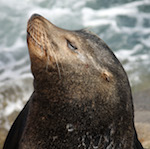Scientists have been tracking the movements of whales, seals, seabirds and turtles along the west coast to identify hot spots that could be better managed to protect marine life from human impacts. A new study reveals areas where human impacts are highest on marine predators. and that many of the high impact areas for the ocean’s top predators are already within the boundaries of five National Marine Sanctuaries along the west coast, covering nearly 15,000 square miles. This means there are good opportunities for improving management strategies.
"We often consider human threats in isolation, but many species are passing through a gauntlet of hazards along the coast," said coauthor Helen Bailey at the University of Maryland Center for Environmental Science’s Chesapeake Biological Laboratory.
“For example, migrating whales are sensitive to underwater noise produced by boats and sonar systems. They are at risk from collisions with ships, and can get entangled in ropes from fishing gear.”
Bailey leads the WhaleWatch project, which uses satellite data and models on the migration of gray whales and several endangered species to help develop conservation policies for reducing ship strikes and entanglements of large whales off the U.S. West Coast.
 Marine mammals and other predators are critical to the health of marine ecosystems. The study used tracking data for eight species of marine predators: blue whales, humpback whales, northern elephant seals, California sea lions, black-footed and Laysan albatrosses, sooty shearwaters, and leatherback sea turtles. These are among the 23 species whose movements have been tracked since 2000 as part of the Tagging of Pacific Predators (TOPP) program. The eight species included in the new study are ecologically important but are not commercially exploited.
Marine mammals and other predators are critical to the health of marine ecosystems. The study used tracking data for eight species of marine predators: blue whales, humpback whales, northern elephant seals, California sea lions, black-footed and Laysan albatrosses, sooty shearwaters, and leatherback sea turtles. These are among the 23 species whose movements have been tracked since 2000 as part of the Tagging of Pacific Predators (TOPP) program. The eight species included in the new study are ecologically important but are not commercially exploited.
The TOPP studies showed that many marine predators travel thousands of miles every year, yet often concentrate within small-scale "hotspots" to breed or feed on fish and other prey. Many such hotspots are found within the California Current System.
Researchers combined the TOPP tracking data with a database of human impacts in the California Current System that was developed by a group led by coauthor Benjamin Halpern at UC Santa Barbara. The relative impact on each species was determined for each of 24 stressors associated with human activities, such as fishing, shipping, climate change, and pollution. The analysis yielded maps showing where the greatest impacts on each species are likely to be.
"Areas where key habitats and human impacts overlap represent important areas for conservation efforts," said lead author Sara Maxwell of Stanford University's Hopkins Marine Station. "In other cases, areas of high human activities are not key habitats for predators. As a result, we can maximize both conservation of marine predators and human uses that our coastal communities depend on."
The study suggests that protecting key habitat without considering human uses may result in missed opportunities for sustainable resource use.
"A major component of the TOPP program was to identify important conservation areas of the North Pacific Ocean. This paper is a significant step forward in increasing our awareness of the 'blue Serengeti' that lies just off the west coast of the U.S.," said coauthor Dan Costa at UC Santa Cruz.
The study, “Cumulative human impacts on marine predators,” involved a team of 23 researchers at 19 institutions. It is published in the October 28 issue of Nature Communications.

